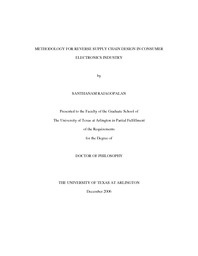| dc.contributor.author | Rajagopalan, Santhanam | en_US |
| dc.date.accessioned | 2007-08-23T01:56:22Z | |
| dc.date.available | 2007-08-23T01:56:22Z | |
| dc.date.issued | 2007-08-23T01:56:22Z | |
| dc.date.submitted | December 2006 | en_US |
| dc.identifier.other | DISS-1538 | en_US |
| dc.identifier.uri | http://hdl.handle.net/10106/258 | |
| dc.description.abstract | Reverse Logistics (RL), the art and science of moving goods typically from the end consumer towards the upstream end of supply chains, has been the subject of many strategic meetings in organizations today. This is attributed mainly due to the tighter federal environmental legislations on product returns and a hugely untapped potential that has been often overlooked by the managers. Traditionally, enterprises spend most of the improvement initiatives in optimizing its forward supply chain (FSC) performance that aims to delight the end consumer. However, it is not a panacea by itself in the process of continuously satisfying the end customer. Managers are now forced to look at their business processes from a more strategic perceptive than ever before. This perspective includes a reverse supply chain (RSC) component that complements its FSC counterpart in closing the supply chain / network of an enterprise. Having an "efficient" RSC solves two issues for an organization: (i) it can utilize its resources more effectively than before and (ii) it can project an "environmentally friendly" image in the eyes of the customer. This research is targeted toward designing an efficient RSC with special attention to the consumer electronics industry.
Efficiency of a RSC is defined across three main dimensions that include: the "time taken to recover value", "actual value recovered from returns", and "number of returns that enter the RSC". This research develops a methodology that helps organizations design their RSC systems. Consequentially, the design seeks to reduce the time taken to recover value, increase the value recovered and to reduce the number of returns that enter the RSC respectively.
These three goals of the methodology are done in three stages. In order to achieve the first goal, a "twelve step" algorithm is developed that measures and suggests measures to reduce the time taken to recover value. Next, a "scoring system" is developed to increase the value recovered from product returns. Finally, a "cause and effect" analysis is done for each influential actor in the supply chain to determine the reason(s) for return in order to develop solutions for curbing them in the future. | en_US |
| dc.description.sponsorship | Liles, Donald | en_US |
| dc.language.iso | EN | en_US |
| dc.publisher | Industrial & Manufacturing Engineering | en_US |
| dc.title | Methodology For Reverse Supply Chain Design In Consumer Electronics Industry | en_US |
| dc.type | Ph.D. | en_US |
| dc.contributor.committeeChair | Liles, Donald | en_US |
| dc.degree.department | Industrial & Manufacturing Engineering | en_US |
| dc.degree.discipline | Industrial & Manufacturing Engineering | en_US |
| dc.degree.grantor | University of Texas at Arlington | en_US |
| dc.degree.level | doctoral | en_US |
| dc.degree.name | Ph.D. | en_US |
| dc.identifier.externalLink | https://www.uta.edu/ra/real/editprofile.php?onlyview=1&pid=261 | |
| dc.identifier.externalLinkDescription | Link to Research Profiles | |

